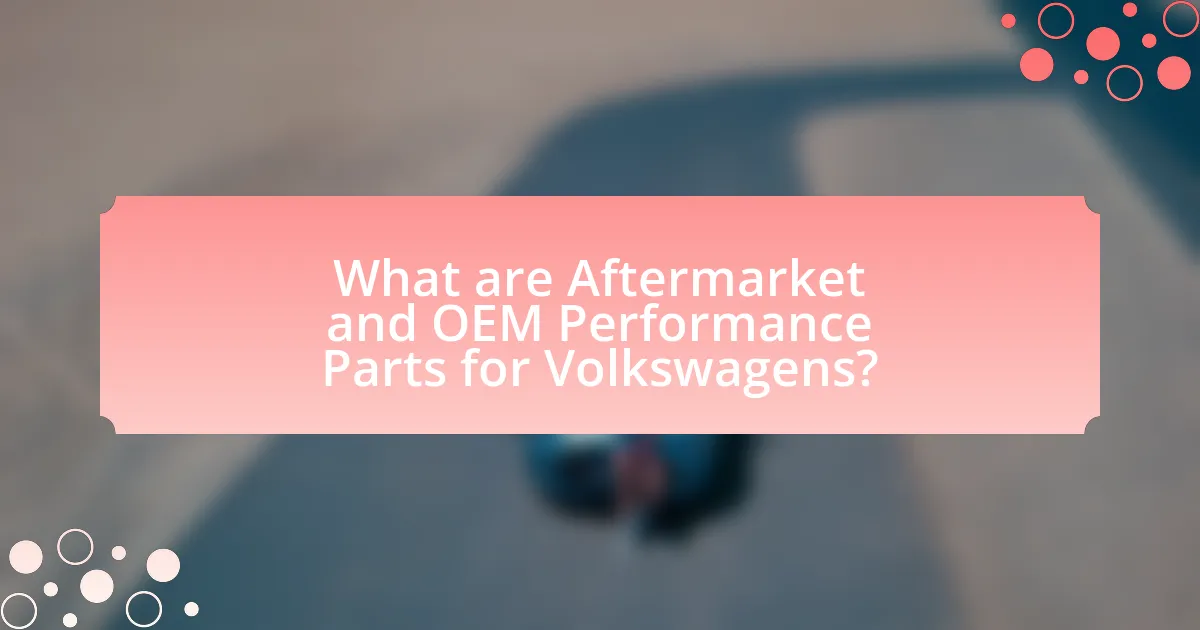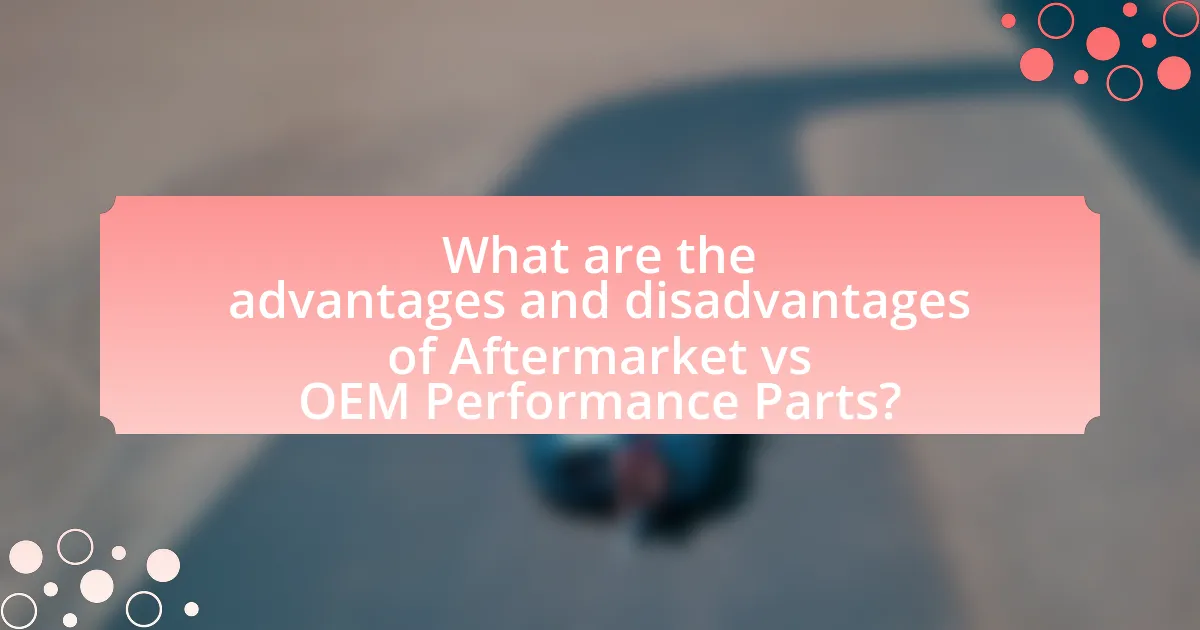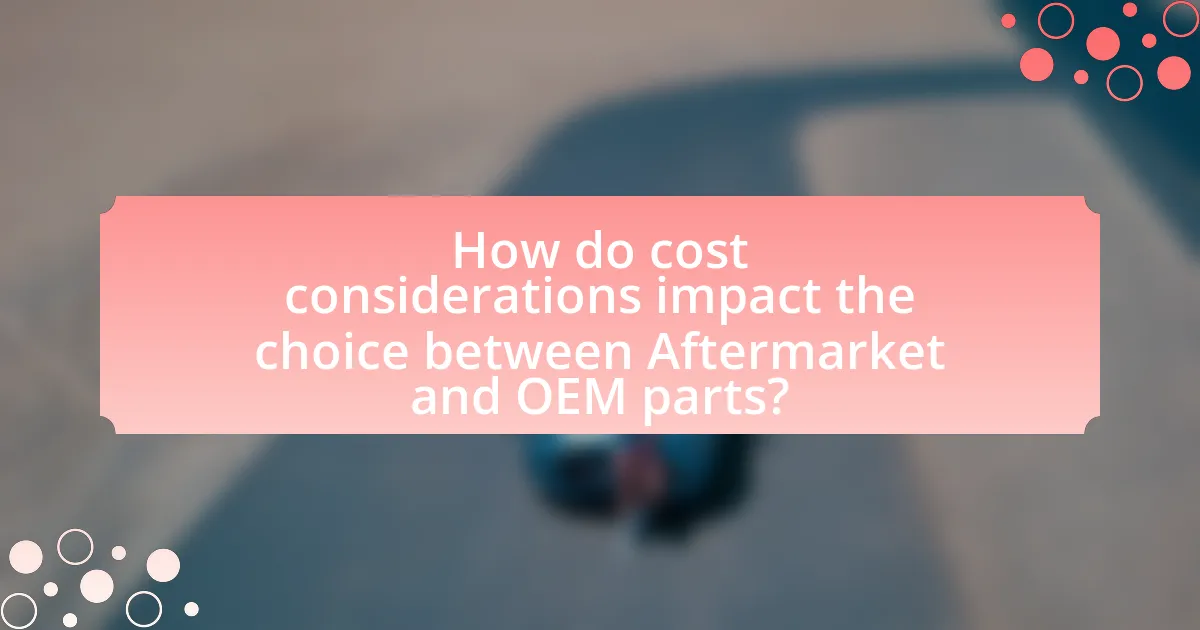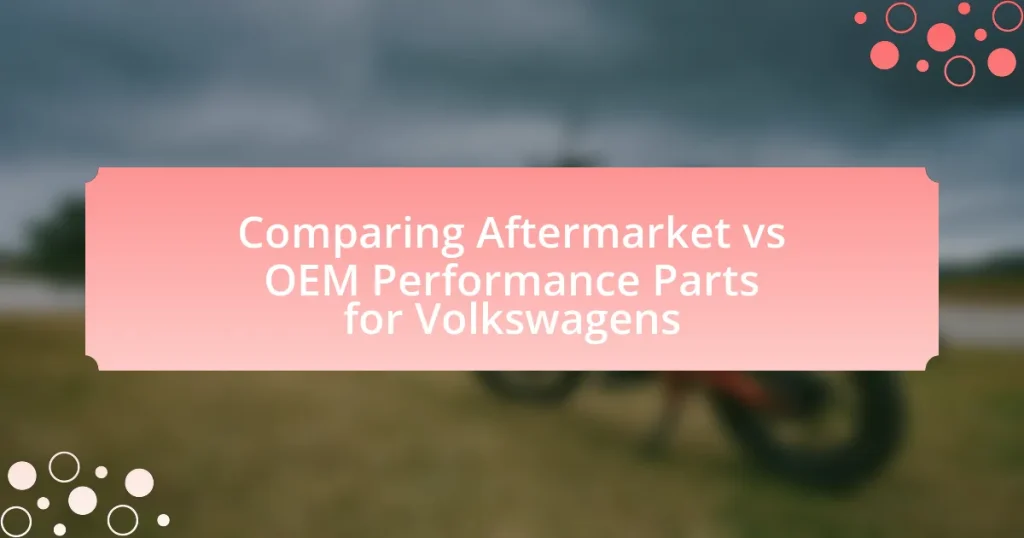The article focuses on the comparison between aftermarket and OEM (Original Equipment Manufacturer) performance parts for Volkswagens. It outlines the definitions, advantages, and disadvantages of both types of parts, highlighting key differences in quality, performance, and cost. Aftermarket parts, produced by third-party manufacturers, offer customization and often lower prices, while OEM parts ensure compatibility and reliability, adhering to Volkswagen’s original specifications. The article also discusses the motivations behind Volkswagen owners’ choices, the impact of cost considerations, and the importance of warranty coverage, providing a comprehensive overview of factors influencing the decision-making process for vehicle enhancements.

What are Aftermarket and OEM Performance Parts for Volkswagens?
Aftermarket performance parts for Volkswagens are components made by third-party manufacturers that enhance vehicle performance, while OEM (Original Equipment Manufacturer) performance parts are produced by Volkswagen or authorized suppliers, designed to meet the original specifications of the vehicle. Aftermarket parts often provide a wider variety of options for customization and performance enhancement, such as improved exhaust systems or suspension kits, whereas OEM parts ensure compatibility and reliability, as they are built to the same standards as the original components. The distinction is significant, as aftermarket parts can vary in quality and performance, while OEM parts guarantee a level of consistency and fitment that aligns with Volkswagen’s engineering standards.
How do Aftermarket and OEM parts differ in quality and performance?
Aftermarket parts generally differ from OEM parts in quality and performance due to variations in manufacturing standards and materials used. OEM parts are produced by the original manufacturer and adhere to strict quality control measures, ensuring compatibility and reliability with the vehicle’s specifications. In contrast, aftermarket parts can vary widely in quality; some may meet or exceed OEM standards, while others may use inferior materials or lack rigorous testing, leading to potential performance issues. For example, a study by the Automotive Aftermarket Industry Association indicates that while some aftermarket parts can offer enhanced performance, they may also introduce risks such as reduced durability or improper fitment, which can affect overall vehicle performance.
What defines OEM performance parts for Volkswagens?
OEM performance parts for Volkswagens are defined as original equipment manufacturer components specifically designed to meet the exact specifications and performance standards set by Volkswagen. These parts are engineered to ensure compatibility, reliability, and optimal performance in Volkswagen vehicles, often undergoing rigorous testing to meet safety and quality benchmarks. For instance, OEM parts are manufactured using the same materials and processes as the original components, which guarantees that they will perform similarly to the parts that came with the vehicle. This adherence to Volkswagen’s standards is crucial for maintaining warranty coverage and ensuring the longevity of the vehicle.
What defines Aftermarket performance parts for Volkswagens?
Aftermarket performance parts for Volkswagens are defined as components that enhance the vehicle’s performance, handling, and aesthetics, produced by third-party manufacturers rather than the original equipment manufacturer (OEM). These parts often include upgrades such as turbochargers, exhaust systems, suspension kits, and performance chips, which are designed to improve horsepower, torque, and overall driving experience. The aftermarket industry for Volkswagens is substantial, with numerous brands offering specialized parts that cater to enthusiasts seeking customization and performance enhancements. According to a report by Grand View Research, the global automotive aftermarket is projected to reach $1.5 trillion by 2025, indicating a strong demand for aftermarket parts, including those for Volkswagen vehicles.
Why do Volkswagen owners choose between Aftermarket and OEM parts?
Volkswagen owners choose between aftermarket and OEM parts primarily due to cost, availability, and performance preferences. Aftermarket parts often provide a more affordable option, appealing to budget-conscious consumers, while OEM parts are typically associated with guaranteed quality and compatibility, as they are manufactured by the original equipment manufacturer. According to a study by the Automotive Aftermarket Industry Association, approximately 60% of vehicle owners consider price as a significant factor in their decision-making process. Additionally, some Volkswagen owners may prefer aftermarket parts for enhanced performance or customization options, which can lead to improved vehicle handling or aesthetics.
What are the primary motivations for choosing Aftermarket parts?
The primary motivations for choosing aftermarket parts include cost savings, enhanced performance, and increased availability. Cost savings are significant as aftermarket parts often come at a lower price compared to OEM parts, allowing consumers to reduce repair and maintenance expenses. Enhanced performance is another motivation, as many aftermarket parts are designed to improve vehicle efficiency, handling, or power, catering to enthusiasts looking for upgrades. Additionally, increased availability is a factor; aftermarket parts are widely accessible through various retailers and online platforms, providing consumers with a broader selection than OEM parts, which may be limited by manufacturer offerings.
What are the primary motivations for choosing OEM parts?
The primary motivations for choosing OEM parts include guaranteed compatibility, quality assurance, and warranty protection. OEM parts are specifically designed for a particular vehicle model, ensuring they fit and function as intended, which reduces the risk of installation issues or performance problems. Additionally, OEM parts are manufactured to the same standards as the original components, providing reliability and longevity. Furthermore, using OEM parts often maintains the vehicle’s warranty, as many manufacturers require the use of original parts for warranty claims. This combination of factors makes OEM parts a preferred choice for many vehicle owners seeking optimal performance and peace of mind.

What are the advantages and disadvantages of Aftermarket vs OEM Performance Parts?
Aftermarket performance parts offer customization and often lower prices, while OEM (Original Equipment Manufacturer) parts ensure compatibility and reliability. Aftermarket parts can enhance performance and aesthetics, providing a wider variety of options tailored to specific preferences. However, they may lack the same quality assurance as OEM parts, potentially leading to fitment issues or reduced longevity. Conversely, OEM parts are designed specifically for the vehicle, ensuring optimal performance and warranty coverage, but they typically come at a higher cost and limited customization options. The choice between the two depends on the balance between desired performance enhancements and the assurance of quality and reliability.
What benefits do Aftermarket performance parts offer to Volkswagen owners?
Aftermarket performance parts provide Volkswagen owners with enhanced vehicle performance, customization options, and often cost savings compared to OEM parts. These components can improve horsepower, torque, and handling, allowing for a more dynamic driving experience. For instance, aftermarket exhaust systems can increase engine efficiency and sound, while performance chips can optimize fuel mapping for better acceleration. Additionally, aftermarket parts typically offer a wider variety of styles and specifications, enabling owners to tailor their vehicles to personal preferences. Cost-wise, aftermarket options can be more affordable than OEM parts, making performance upgrades accessible to a broader range of Volkswagen enthusiasts.
How can Aftermarket parts enhance vehicle performance?
Aftermarket parts can enhance vehicle performance by providing improved specifications and features that exceed those of original equipment manufacturer (OEM) parts. These enhancements often include better airflow, increased horsepower, and improved handling characteristics. For example, aftermarket exhaust systems can reduce back pressure, allowing engines to breathe more freely, which can lead to a measurable increase in power output. Additionally, aftermarket suspension components can offer better stability and responsiveness, resulting in improved handling during cornering. Studies have shown that vehicles equipped with high-performance aftermarket parts can achieve up to 20% more horsepower compared to their OEM counterparts, demonstrating the tangible benefits of these modifications.
What are the potential risks associated with Aftermarket parts?
The potential risks associated with aftermarket parts include reduced quality, compatibility issues, and potential warranty voiding. Aftermarket parts may not meet the same manufacturing standards as Original Equipment Manufacturer (OEM) parts, leading to premature failure or suboptimal performance. Compatibility issues can arise if the aftermarket part does not fit correctly or function as intended with the vehicle’s existing systems, which can result in further damage or safety hazards. Additionally, using aftermarket parts can void warranties provided by manufacturers, as many warranty policies stipulate that only OEM parts should be used to maintain coverage.
What benefits do OEM performance parts provide?
OEM performance parts provide enhanced reliability and compatibility with Volkswagen vehicles. These parts are specifically designed and manufactured by the original equipment manufacturer, ensuring they meet the exact specifications and quality standards set by the vehicle’s maker. This results in improved performance, as OEM parts are engineered to work seamlessly with the vehicle’s systems, reducing the risk of malfunctions or failures. Additionally, using OEM parts can help maintain the vehicle’s warranty and resale value, as they are recognized for their quality and authenticity.
How do OEM parts ensure compatibility and reliability?
OEM parts ensure compatibility and reliability by being manufactured to the exact specifications set by the original equipment manufacturer. This adherence to precise standards guarantees that each part fits seamlessly with the vehicle’s existing components, minimizing the risk of malfunction or incompatibility. For instance, OEM parts undergo rigorous testing and quality control processes, which are often documented in industry standards, ensuring they meet the performance and safety requirements established by the manufacturer. This level of quality assurance is critical for maintaining the vehicle’s performance and longevity, as evidenced by studies showing that vehicles using OEM parts experience fewer breakdowns and repairs compared to those using aftermarket alternatives.
What are the limitations of using OEM parts?
The limitations of using OEM parts include higher costs, limited availability, and potential lack of performance enhancements. OEM parts are typically more expensive than aftermarket alternatives, which can strain budgets for repairs or upgrades. Additionally, OEM parts may not always be readily available, leading to longer wait times for repairs. Furthermore, while OEM parts are designed to meet original specifications, they often do not offer the performance improvements that some aftermarket parts provide, which can be a disadvantage for enthusiasts seeking enhanced vehicle performance.

How do cost considerations impact the choice between Aftermarket and OEM parts?
Cost considerations significantly influence the choice between Aftermarket and OEM parts, as Aftermarket parts typically offer lower prices compared to OEM parts. This price difference can lead consumers to favor Aftermarket options, especially when budget constraints are a primary concern. For instance, Aftermarket parts can be up to 50% cheaper than their OEM counterparts, making them an attractive choice for cost-sensitive consumers. However, while Aftermarket parts may save money upfront, they can sometimes compromise on quality and reliability, which may result in higher long-term costs due to potential failures or the need for replacements. Therefore, the decision often hinges on balancing immediate cost savings with the potential for future expenses related to performance and durability.
What is the typical price range for Aftermarket performance parts?
The typical price range for aftermarket performance parts is between $50 and $2,000, depending on the type and complexity of the part. For instance, basic components like air filters or exhaust tips may cost around $50 to $200, while more advanced parts such as turbochargers or suspension kits can range from $500 to $2,000. This pricing reflects the variety of aftermarket options available for vehicles, including Volkswagens, where enthusiasts often seek enhancements for performance and aesthetics.
How do installation costs compare between Aftermarket and OEM parts?
Installation costs for aftermarket parts are generally lower than those for OEM parts. This cost difference arises because aftermarket parts often have more competitive pricing due to a wider range of manufacturers and less stringent quality control compared to OEM parts, which are produced by the original manufacturer and typically come with higher labor costs associated with their installation. For example, a study by the Automotive Aftermarket Industry Association indicates that installation costs for aftermarket parts can be up to 20% less than those for OEM parts, reflecting the overall savings that consumers can experience when choosing aftermarket options.
What is the typical price range for OEM performance parts?
The typical price range for OEM performance parts is between $100 and $1,500, depending on the specific part and vehicle model. For instance, basic components like air filters may cost around $100, while more complex parts such as exhaust systems or turbochargers can reach up to $1,500. This pricing reflects the quality and reliability associated with OEM parts, which are designed to meet the manufacturer’s specifications and standards.
How does warranty coverage differ between Aftermarket and OEM parts?
Warranty coverage for Aftermarket parts typically differs from that of OEM parts in terms of duration and conditions. OEM parts usually come with a warranty that aligns with the vehicle manufacturer’s warranty, often lasting several years or up to 100,000 miles, ensuring that they meet specific quality and performance standards. In contrast, Aftermarket parts may have shorter warranty periods, often ranging from 30 days to a few years, and the coverage can vary significantly between manufacturers. This discrepancy arises because OEM parts are produced to the exact specifications of the vehicle manufacturer, while Aftermarket parts may not always adhere to the same quality controls, leading to potential variations in reliability and performance.
What should Volkswagen owners consider when making a choice?
Volkswagen owners should consider the compatibility, quality, and warranty of performance parts when making a choice between aftermarket and OEM options. Compatibility ensures that the parts fit and function correctly with their specific vehicle model, while quality affects performance and longevity; OEM parts are typically manufactured to the same standards as the original components, whereas aftermarket parts can vary widely in quality. Additionally, warranty coverage is crucial, as OEM parts often come with manufacturer warranties, providing peace of mind regarding defects or failures, while aftermarket parts may have limited or no warranty. These factors are essential for ensuring optimal vehicle performance and reliability.


